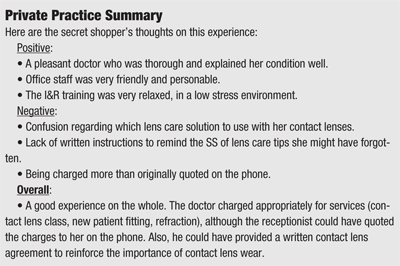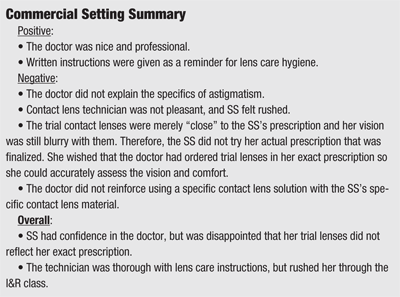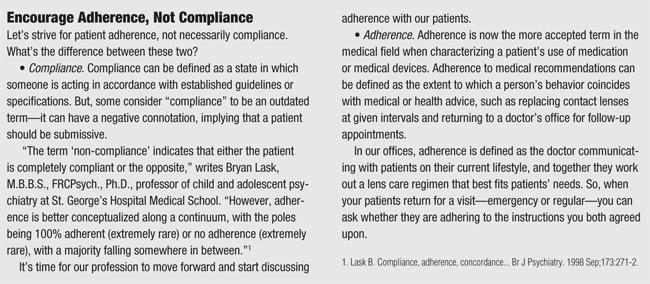Have you ever wanted to compare your everyday practices with those of other eye care practitioners to see how you measure up? I have. I just had to know how my counterparts dispensed contact lenses to new patients and what recommendations they gave about contact lens replacement schedules, hygiene and overall use.
To find out, I recruited my wife to go undercover as a secret shopper (SS) and investigate different eye care enterprises inquiring about contact lenses for the first time. (All names of doctors, staff, and locations will remain anonymous, and won’t be disclosed for any reason.) My wife has helped me in my new office with several tasks, including insertion and removal (I&R) classes, but she is not an optician or an optometrist. She tried contact lenses once about one year prior to this assignment for one hour, but never inserted them herself. So, at the time of this investigation, she was considered a new wearer with a current spectacle prescription.

As the secret shopper, my wife’s assignment was to listen and observe the new patient experience, but not to ask any pointed questions that a typical patient wouldn’t ask. After each visit, she made notes in her journal of what was said, not said and written down.
The practices selected for this investigation were chosen due to their close proximity to the SS residence and also because the practitioners had never met the SS.
The first office she visited was a private practice in a standalone building on a major two-lane road in a suburb of Columbus, Ohio. The second office can be described as a “big box” retailer in Columbus. Both offices are located in affluent areas. (Please note that these locations were not selected to compare private practice vs. commercial eye care.)
Established Private Practice

The SS called to make an appointment and explained to the receptionist that she already had a current spectacle lens prescription, but wanted to try contact lenses. The SS inquired if the doctor would perform a contact lens fitting. The receptionist responded, “Yes, you will be charged $120 [amount used as example only] for a new patient contact lens fitting,” and then proceeded to schedule her first appointment.
Upon arriving, the SS filled out some new patient paperwork and then was taken back for pre-testing, where keratometry was performed. After some small talk, the doctor asked why she wanted contact lenses and measured her spectacle lens prescription again. After refraction, the doctor sat down and explained that the SS suffers mainly from astigmatism and that her astigmatism is somewhat unusual because most astigmatism is vertically- or horizontally-oriented, but the SS’s astigmatism was more diagonal or oblique.
Due to her “diagonal” astigmatism, he said that he would order some trial contact lenses specific to her prescription. The office would notify her when they arrived and she would need to come in for another visit, during which the doctor would teach her I&R techniques as well as check her vision and the fit of the lenses.
At the end of the initial visit, the SS was charged for the refraction ($55), the contact lens evaluation ($40), two boxes of contacts that she hadn’t tried yet ($39 per box) and the new patient fitting fee that she was originally quoted ($120).
The doctor informed the SS that her lenses would be monthly-replacement when she did buy them; however, her invoice for the contact lenses was for Acuvue Oasys for Astigmatism (two-week replacement lenses). The SS asked to pay for only the services rendered during that day’s visit. Her total: $215.
Approximately one week later, the SS received a phone call stating that her trial lenses were in, and she scheduled an appointment for I&R training and follow-up care. At the I&R appointment, the SS asked the technician if a particular solution should be used to soak her lenses in at night.
“Stick with the solution in the kit we’re going to give you today and don’t switch without consulting us first,” the technician replied. But, then the technician rinsed the SS’s lenses in a competitor’s multipurpose solution before having her insert the lenses for the first time, which confused the SS about which solution to purchase for her care.
Below are the verbal instructions for compliance given to the SS:
• Wash and dry hands before inserting and removing lenses.
• Don’t sleep in your lenses because the tear film would reduce overnight and the lenses would adhere to your eye.
• Don’t swim or shower in your lenses because they “pop off.”
• Don’t top-off your contact lens solution.
• Rinse lenses with approved solution before inserting them.
The vision center staff member showed the SS how to insert the lenses, remove the lenses and care for them. The staff member gave the SS written instructions for wear time only. The wearing time was four hours for the first day; the SS was told to increase this time by one hour per day until she reached eight hours of lens wearing time. She was told not to exceed eight hours of wear until her next follow-up visit. The SS cancelled this visit because we obtained enough information to fulfill the obligations of this article.
Commercial Setting

When the SS called to make an appointment requesting a contact lens fitting, the vision center staff member was not sure whether they would be able to accommodate her and had to check with the doctor. After checking with the doctor, the staff member scheduled the SS’s contact lens appointment and told her it would be $30 for a new patient fitting.
Upon arrival, the SS filled out some basic information and provided a copy of the spectacle prescription. She was taken back to the exam room, where the doctor performed keratometry and refraction.
After refraction, the doctor pulled some contact lenses and applied them to the SS’s eyes. The doctor stated that these contact lenses were close but not exactly her prescription. The doctor also stated that these particular contact lenses were monthly replacement lenses. Her prescription was for Air Optix for Astigmatism (CIBA Vision), which are monthly replacement lenses. The doctor told her, “Here is your contact lens prescription, but don’t fill it until I see you back next week.” The SS was not charged for refraction or a contact lens fitting evaluation.
Then the doctor turned the SS over to a vision center staff member who asked to examine the SS’s fingernails. The staff member then asked the SS to clip her fingernails on the spot to prevent any scratching of the eye while inserting or removing her lenses. The SS was glad that no fingernail clippers could be found!
The vision center staff member then proceeded to do the insertion and removal training. Here are the written instructions that were provided and verbally reviewed by the vision care center staff:
• Care: Day one, wear contacts four to six hours, then increase two to four hours each day until you can wear them all day.
• Cleaning: Rinse contact case daily [but the instructions didn’t state whether to use a particular solution or tap water]. If the contact collects debris (falls to the floor), simply place contact in the palm of your hand, put two drops of solution in the contact and lightly message contact in a circular motion. Always wash your hands prior to putting contacts in your eyes. This prevents the contact from collecting oil from your hands and causing an irritable burning sensation.
• Safety: No swimming, showering, bathing of any sort, or sleeping.
A follow-up visit was scheduled and the SS returned to see how the prescription would be finalized. At this visit, the doctor asked if the SS had increased her wearing time to at least eight hours per day. When she reported, “yes,” he wrote out the same prescription that he gave to the SS the week before and said that the SS was OK to order this contact lens prescription, even though she hadn’t tried that actual prescription.
The SS asked the doctor what contact lens solution to use with her contact lenses. “They are all pretty much the same, so whatever feels the most comfortable,” he replied.
Examine Your Office
These are just two encounters that briefly describe current contact lens procedures. Had the SS visited more offices, she would have uncovered many different ways contact lenses are dispensed.
I hope this article will inspire you to re-examine the contact lens procedures in your office and the overall message conveyed to your patients.
Do you think the SS’s experiences would lead her to acceptable adherence with her contact lens care? Set the standards in your office for contact lens care adherence. Make sure your actions reinforce your message––both verbal and written.
Use the adherence checklist as a starting point for discussion with each patient. Make sure you and your staff members are familiar with each question on the sheet, and that every staff member in your office understands how to properly answer any follow-up questions that may arise.
Most importantly, emphasize to the patient the importance of contact lenses as medical devices, and reinforce your role as your patients’ eye care practitioner—not merely their contact lens provider.
By emphasizing this during every new patient exam, you ensure that patients regularly visit your practice for contact lens care, ultimately improving the chances of successful contact lens wear.
Dr. Mayers is in private practice in Powell, Ohio, and specializes in contact lenses.












